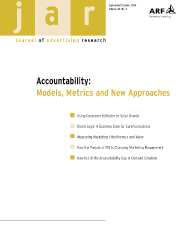Article contents
Overcontrol in Advertising Experiments
Published online by Cambridge University Press: 19 June 2003
Extract
Market A is selected as the test city. Three levels of advertising “frequency” are to be tested by beaming corresponding numbers of commercials to three groups of randomly selected households. Sales to the three groups are to be measured with either diary panel data or scanner data. Since market A has been determined to be representative of the total area under consideration, the three levels of purchase probability associated with the levels of advertising are to be used in constructing an advertising-sales response function for budgeting purposes.
According to many (Simon and Arndt, 1980, for example), such an experiment manifests the state of the art for assessing the effects of advertising on sales. This paper argues that such state-of-the-art experiments overcontrol the environment, and hence may mismeasure the effects of advertising. More specifically, a single-market experiment may control “away” effects of advertising.
- Type
- Research Article
- Information
- Copyright
- Copyright © The ARF 2000
- 4
- Cited by


